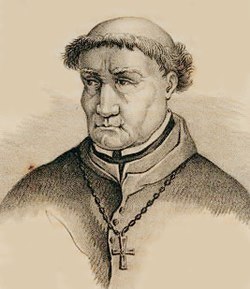| From | To | Grand Inquisitor | Other positions held |
|---|
| 1518 | 1522 | Adrian of Utrecht | Cardinal priest of Ss. Giovanni e Paolo, Bishop of Tortosa, later Pope |
| 1523 | 1538 | Alonso Manrique de Lara | Bishop of Badajoz, Archbishop of Seville, Cardinal |
| 1539 | 1545 | Juan Pardo de Tavera | Archbishop of Toledo |
| 1546 | 1546 | García de Loaysa | Archbishop of Seville |
| 1547 | 1566 | Fernando de Valdés y Salas | Archbishop of Seville |
| 1566 | 1572 | Diego de Espinosa | Bishop of Sigüenza, Bishop of Cuenca |
| 1572 | 1572 | Pedro Ponce de León | Bishop of Ciudad Rodrigo, Bishop of Plasencia |
| 1573 | 1594 | Gaspar de Quiroga y Vela | Archbishop of Toledo |
| 1595 | 1595 | Jerónimo Manrique de Lara | Bishop of Cartagena, Bishop of Ávila |
| 1596 | 1599 | Pedro de Portocarrero | Bishop of Calahorra, Bishop of Cuenca |
| 1599 | 1602 | Fernando Niño de Guevara | Archbishop of Seville |
| 1602 | 1602 | Juan de Zúñiga Flores | Bishop of Cartagena |
| 1603 | 1608 | Juan Bautista de Acevedo | Bishop of Valladolid, Patriarch of the West Indies |
| 1608 | 1618 | Bernardo de Sandoval y Rojas | Archbishop of Toledo |
| 1619 | 1621 | Luis de Aliaga Martínez | |
| 1622 | 1626 | Andrés Pacheco | Bishop of Cuenca, Patriarch of the West Indies |
| 1627 | 1632 | Antonio de Zapata Cisneros | Archbishop of Burgos |
| 1632 | 1643 | Antonio de Sotomayor | Prior of Santo Domingo |
| 1643 | 1665 | Diego de Arce y Reinoso | Bishop of Tuy, Bishop of Avila, Bishop of Palencia |
| 1665 | 1665 | Pascual de Aragón | Archbishop of Toledo |
| 1666 | 1669 | Juan Everardo Nithard | |
| 1669 | 1695 | Diego Sarmiento de Valladares | Bishop of Oviedo, Bishop of Plasencia |
| 1695 | 1699 | Juan Tomás de Rocaberti | Prior of Santo Domingo, Archbishop of Valencia |
| 1699 | 1699 | Alonso Fernández de Córdoba y Aguilar | Appointed Grand Inquisitor, but died before he could assume this office. |
| 1699 | 1705 | Baltasar de Mendoza y Sandoval | Bishop of Segovia |
| 1705 | 1709 | Vidal Marín del Campo | Archbishop of Burgos |
| 1709 | 1710 | Antonio Ibáñez de Riva Herrera | Archbishop of Zaragoza, Archbishop of Toledo |
| 1711 | 1716 | Francesco del Giudice | Archbishop of Monreale |
| 1715 | 1715 | Felipe Antonio Gil de Taboada | Commissioned as Grand Inquisitor but did not serve. |
| 1717 | 1717 | José de Molines | Proclaimed in Rome, but detained by Austrians and died without serving. |
| 1718 | 1718 | Felipe de Arcemendi | Died without serving. |
| 1720 | 1720 | Diego de Astorga y Céspedes | Archbishop of Toledo |
| 1720 | 1733 | Juan de Camargo y Angulo | Bishop of Pamplona |
| 1733 | 1740 | Andrés de Orbe y Larreategui | Archbishop of Valencia |
| 1742 | 1746 | Manuel Isidro Orozco Manrique de Lara | Archbishop of Santiago |
| 1746 | 1755 | Francisco Pérez de Prado | Bishop of Teruel |
| 1755 | 1774 | Manuel Quintano Bonifaz | Titular Archbishop of Farsala |
| 1775 | 1783 | Felipe Beltrán Serrano | Bishop of Salamanca |
| 1784 | 1793 | Agustín Rubin de Ceballos | Bishop of Jaén |
| 1793 | 1794 | Manuel Abad y Lasierra | Titular Archbishop of Selymbria |
| 1794 | 1797 | Francisco Antonio Lorenzana y Butrón | Archbishop of Toledo |
| 1797 | 1808 | Ramón José de Arce y Rebollar | Archbishop of Burgos |
| 1808 | 1814 | Abolition of the Inquisition | |
| 1814 | 1818 | Francisco Javier Mier Campillo | Bishop of Almería |
| 1818 | 1818 | Cristóbal Bencomo y Rodríguez | Titular Archbishop of Heraclea (position rejected by himself) [2] |
| 1818 | 1820 | Gerónimo Castillón y Salas | Bishop of Tarazona |
|






